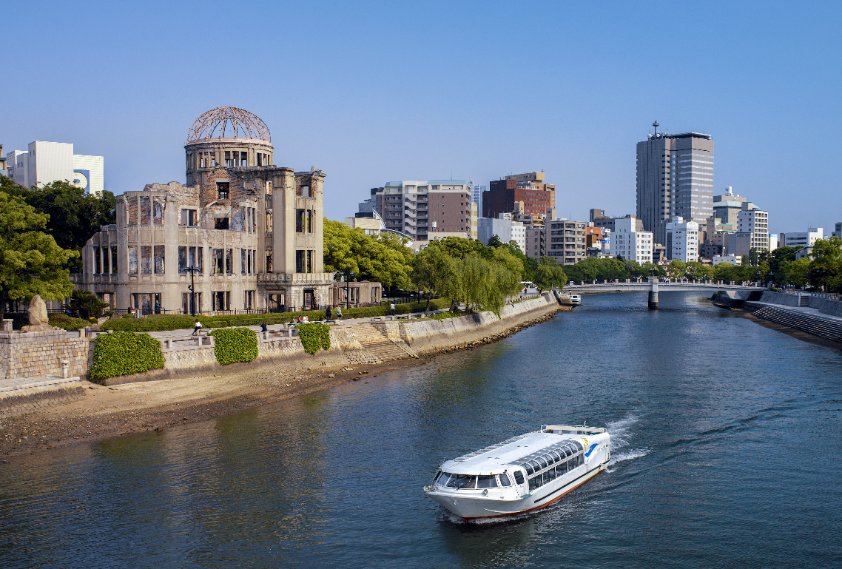Average temperature of Japan in 1945

Average temperature of Japan in 1945
Was there anything unusual about the average temperature in Japan in 1945?
Did the atomic bombs affect the average temperatures in Hiroshima and Nagasaki of 1945?
1945 was the year when Japan surrendered to the Allies. It was also the year when atomic bombs were dropped on the cities of Hiroshima and Nagasaki. Here, we will look at the subject of the average temperature in Japan in 1945, as some people wonder if the atomic bombs had any effect on the temperature.
Atomic bombing of Hiroshima and Nagasaki in August, 1945
A uranium-type atomic bomb was dropped from a B-29 bomber, the Enola Gay, over the city of Hiroshima on August 6.
The atomic bomb was said to have power equivalent to 20,000 tons of TNT gunpowder. The enormous energy produced an instantaneous burst of high-temperature heat and radiation, and the tremendous blast caused damage unparalleled by conventional bombs.
The area within a two-kilometer radius of the hypocenter was completely burned to the ground. The blast destroyed most of the houses in the surrounding area, leaving Hiroshima a burnt-out ruin. The city of Hiroshima estimated that approximately 140,000 people had died by the end of December of that year.
Furthermore, on August 9, a B-29 “Boxcar” bomber dropped a plutonium atomic bomb on Nagasaki. The death toll was estimated at 74,000 by December of the same year.
Extremely high temperature caused by the atomic bombs
The temperature of the fireball created when the atomic bomb exploded exceeded 1 million degrees Celsius at its center. Its maximum size was 280 meters in diameter after one second. The extremely strong heat rays emitted from the fireball caused the ground surface temperature at the hypocenter to rise to 3,000-4,000 degrees Celsius (the surface temperature of the sun is 5,700 degrees Celsius and the temperature at which iron melts is 1,500 degrees Celsius).
Did the heat of atomic bombs have any effect on the average temperature of Japan in 1945?
Because the atomic bombs caused extremely high temperatures at the bombing sites, some people wonder if the bombs affected the average temperature of Japan in 1945. On social media, some people might say that they did but this is misinformation.
Is it possible that the extremely high temperature caused by the atomic bombs affected the average meteorological temperature of the area or the entire nation?
No. The atomic bombs did not have any particular effect on the “meteorological” temperature. The summer of 1945 was not particularly hot nationwide.
Tokyo was the only place in Japan where the average monthly temperature was above normal in August. The average temperature in Tokyo in August of that year was 26.7 degrees Celsius, while the average temperature in previous years was 26.4 degrees Celsius. The average monthly temperature in Fukuoka in August, 1945 was 27.2 degrees Celsius, while the average temperature in previous years was 28.1 degrees Celsius. In other major cities, including Sendai, Sapporo, and Fukuoka, the average temperatures in August of that year were lower than those of previous years.
In fact, cold damage to crops was reported in Northern Japan that year due to the low temperature in the summer of 1945.
Temperatures in Hiroshima in August, 1945
The temperatures recorded by the Japanese Meteorological Agency for Hiroshima City on August 5-8, 1945 are as follows:
| Date | Average | Maximum | Lowest |
| Aug 5 | 27.9 | 32.2 | 24.3 |
| Aug 6 | 27.4 | 31.5 | 23.4 |
| Aug 7 | 27.7 | 30.8 | 25.2 |
| Aug 8 | 26.3 | 29.9 | 21.9 |
Temperatures are in degrees Celsius.
As you can see, the average temperature of Hiroshima in 1945 would be quite normal considering the temperatures on these days in August. Date of atomic bombing was Aug 6.
Ambient temperature in Hiroshima, August 6, 1945
There is no particular record that shows anything unusual about the ambient temperature on the day of August 6, 1945.










